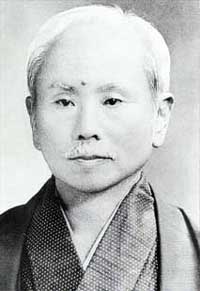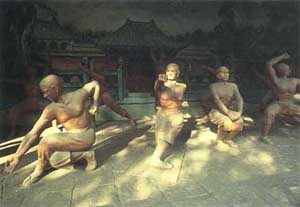The word karate is derived from two words ‘kara’ meaning empty and ‘te’ meaning hand. Thus karate can be translated to, ‘the way of the empty hand’ – a method of fighting without using weapons.

The complete origins of karate will never be completely known, as much of the written history has been lost, and there have been many periods of time when the martial arts were forbidden and practised only in secret. The legend of Bodhidharma, a Shaolin monk, tells how he travelled from India to China and taught the Chinese monks the exercises he had learned from the Vajramushti warriors in India. Boddhidharma beliefs are said to be responsible for the origins of Zen Buddhism.
The arts of the Shaolin monks are then known to have spread over the centuries not just through China but beyond, evntually reaching Okinawa, one of the Ryukyu chain of islands (now a part of Japan).
Perhaps openly, perhaps in secret, the native Okinawan people developed the Okinawa-te Martial Art, a true forerunner of modern-day Karate-do, in order to protect themselves and their families against bandits and raiders. The Okinawan martial art was influenced by the arts practised by the Shaolin monks which had filtered through as traders travelled to and from the island from Japan, China and Korea.
In the last decades of the 19th century, Gichin Funakoshi, himself an Okinawan, learned the techniques of Karate-do at the hands of he great Okinawan Masters Azato and Itosu (amongst others). Later, in 1921 Master Funakoshi was invited to mainland Japan to give a Karate demonstration at a traditional martial arts exhibition.

Attending this exhibition was the soon to be Emperor Prince Hirohito. The next year, 1922, Master Funakoshi established the first dojo for Karate-do in Tokyo, Japan.
The word Shotokan comes from two words ‘Shoto’ and ‘kan’. ‘Shoto’ was Funakoshi’s pen name meaning ‘pine waves’ (derived from his love of walking in the foothills of Mount Torao in Okinawa and hearing the pine leaves rustling in the breeze), and ‘kan’ meaning traning place. Funakoshi’s first dojo (training hall) became known as the Shotokan. Funakoshi’s son, Yoshitaka, was also responsible for further developing the art. He introduced lower stances, and additional kicking techniques, particularly with the head as a target, as previously kicks were mainly aimed at the lower body. When Master Funakoshi became to old to continue teaching, Yoshitaka was appointed as the chief instructor. Although Yoshitaka contributed much to the Shotokan style, he died relatively young and has remained a fairly obscure karate pioneer. Today Shotokan is the most widely practiced style of karate around the world.